Ableton Detune vs Transpose: How are they different? How are they similar?
In this article, I explain how Ableton’s transpose and detune are different.
I will also explain how these functions could be used in Ableton Live.
Let’s dive straight in.
What Does Transpose And Deune Do?
To see the transpose and detune functions, it helps to click on an audio sample.
Left-click on the sample in the arrangement view and notice in the clip view below that there is a transpose and detune option for the clip.
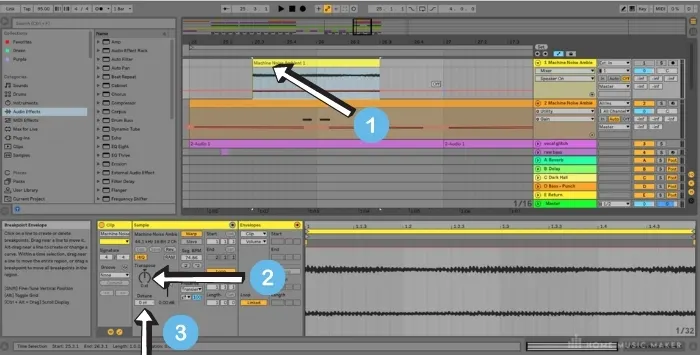
The transpose knob allows you to warp the pitch of the audio clip up to forty-eight semitones above or beneath the original audio sample’s pitch.
The detune function allows you to tune the sample between semitones by 50 degrees (called ‘cents’).
So if you set the detune dial to 25ct, your sample will be tuned halfway between the current setting and the next semitone.
You can use the transpose and detune dials to tune an element (say, a drum sample), although there are many ways to use these functions.
Transposing To Create Harmonies
Apart from simply changing the sample’s pitch (which you can do with the Transpose dial), you can use this function to create harmonies.
To create a harmony, duplicate the track that the sample is on.
Then select the duplicated clip.
With the clip selected, change the pitch of the duplicated clip.
For this example, I have used the Transpose dial to pitch-shift the duplicated clip to +6 semitones.
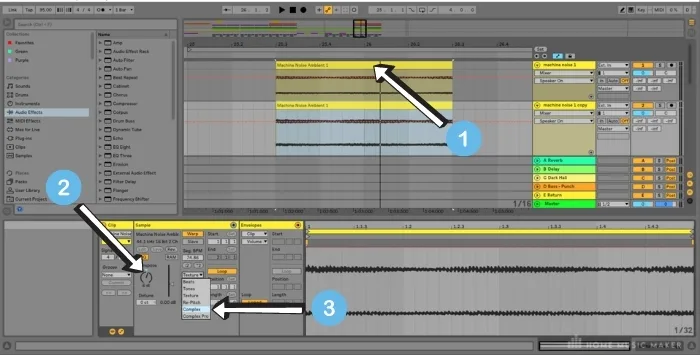
You may need to trial different warp settings to have the duplicated and pitch-shifted sample to match the tempo of the original sample.
A common trick in sound design is to pitch shift a recurring element up an octave at the song’s peak.
Transposing In Sound Design
Playing with transposition can radically change the sound of your sample. You can mess with the warping options to see how each warping algorithm handles the change in pitch.
For instance, if you transpose the sample above or below the sample’s original pitch and select the complex pro warp mode, the sample will sound very different if you selected the texture algorithm.
Sound designers mess around with transposition and warping functions to create new sounds and samples to play with.
If you are happy with the change in pitch, you can consolidate the sample to keep these changes (by right-clicking on the clip and selecting Consolidate or by left-clicking on the clip and pressing Ctrl+J.
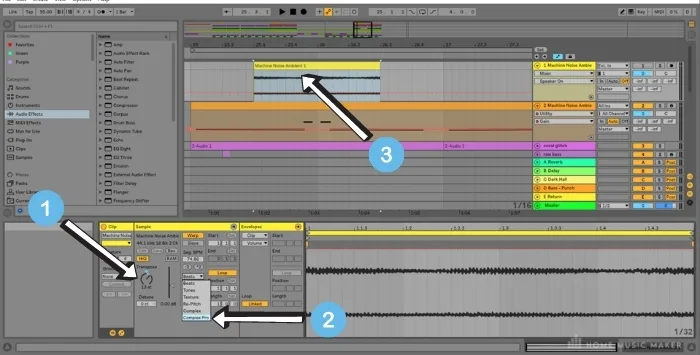
You can then continue to mess with the sample even further, using the transpose and detune functions.
Modulating Transposition
Another common use of the Transpose function is to modulate a sample’s pitch, typically from low to high.
This is a common effect used in most electronic music to build tension before the next section of the song. It can be used on snare drums and toms, white noise, a chord, or in this instance, a textural sound.
Unlike other forms of automation that take place in the automation lane in the arrangement view, this type of ‘modulation’ is set in the clip itself.
Select the clip that you want to modulate.
In the envelopes box on the Clip View, select the drop-down menu from the Control Chooser and select Transposition Modulation.
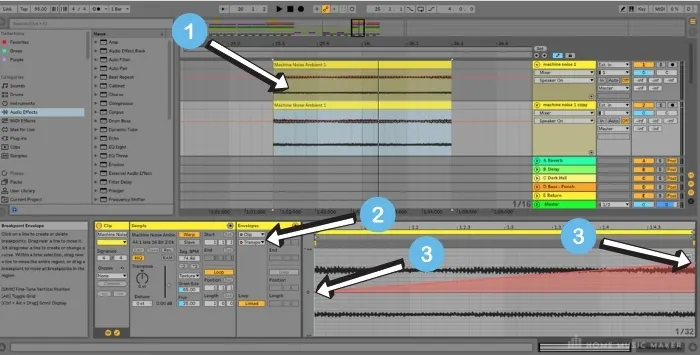
Set your automation points.
As you can see here, I have set the transposition to climb from 0 semitones (the sample’s original pitch) to +8 semitones.
Using Detune For Width
A cool way to use the detune function is to shift it up or down on spacious elements like a synth or a pad. This is an old-school trick to make your synths sound ‘wider.’
important
Keep in mind that the detune option will not appear when you select midi clips on a midi track.
To detune a sample, convert a midi clip to audio by right-clicking on the midi clip and selecting Freeze. Right-click the sample again and select Flatten.
The midi clip will now be an audio clip that you can select and detune.
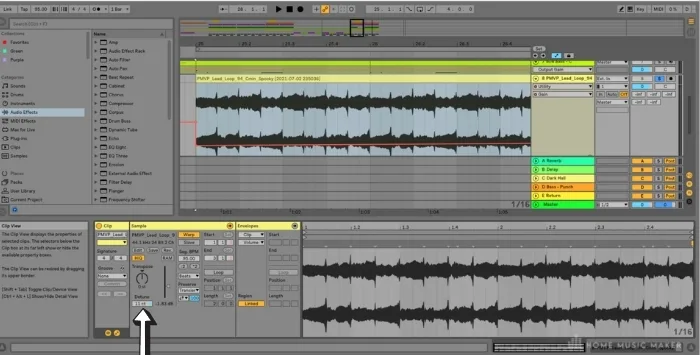
Using Detune To Change The Tone Of A Sample
Messing with the detune dial in more extreme ways can change the tone of the sample quite dramatically.
For example, radically detuning an audio sample to -30 ct or less can make your sample sound darker in tone.
This can be used in more edgy genres or wherever tension is needed.
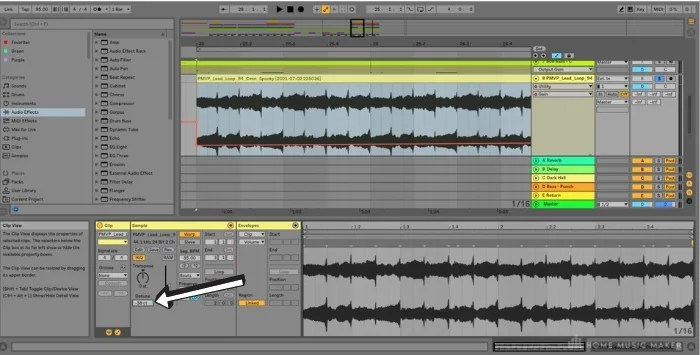
Modulate Detune
You cannot automate the detune parameters in Ableton. However, you can modulate the detune parameters of an audio clip by following Modulating Transposition section above.
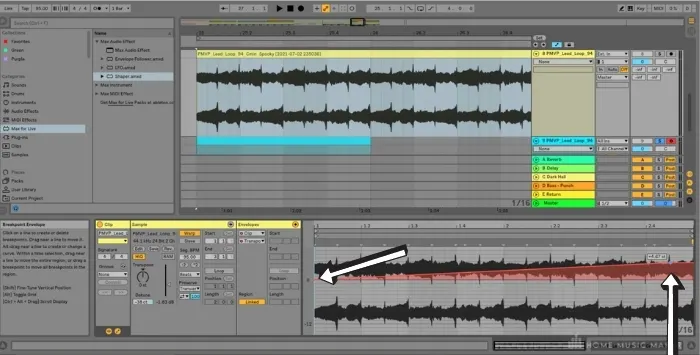
To modulate between semitones, hold down Shift when you set your automation points.
This will allow you to modulate between semitones.
FAQ – Ableton Detune vs Transpose
What is transpose in Ableton?
It allows you to change the pitch of a sample.
What does detune do in Ableton?
It allows you to select pitches between semitones.
What does ct mean in Ableton?
It means ‘Cents,’ and it refers to the pitch increments between semitones.
Can you transpose in Ableton?
Absolutely, following the methods we have discussed above.
How do you transpose a sample?
Follow steps 2 and onwards in this article.
How do you transpose midi notes?
In Clip View, select Pitch Bend in Envelopes > Control Chooser. Use that to automate the pitch of your midi clip.
Final Words
As you can see from above, you can do plenty with Ableton’s Detune and Transpose controls.
I have come up with some fantastic sound designs by simply messing around with them, along with the different Warp modes.
The best thing you can do is play around and experiment with both controls and see what you come up with.

 Want to connect with other music producers for help and guidance?
Want to connect with other music producers for help and guidance?
Oz
Wednesday 5th of July 2023
You said, "you can modulate the detune parameters of an audio clip by following step 4 to modulate the transposition of the audio sample."
Problem: There are no numbered steps on anything here, and it isn't obvious what you're talking about.
Matt
Friday 7th of July 2023
Thanks for pointing that out Oz. It looks like it's refereeing to the Modulating Transposition above in the article. I'll have to dive in and take a closer look.